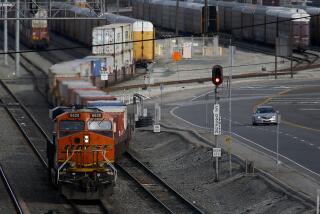CSX Places an Order for 300 Locomotives : Transportation: Move gives GE latest victory in battle to provide more powerful alternating-current models.
- Share via
JACKSONVILLE, Fla. — CSX Transportation Inc. said Wednesday that it ordered 300 locomotives from a General Electric Co. unit, in the latest battle for orders from resurgent railroads that are replacing their aging equipment with new technology.
Financial terms of the sale to the subsidiary of Richmond, Va.-based CSX Corp. were not disclosed, but, based on industry averages, the price is estimated to be about $575 million.
GE and General Motors Corp. are vying to sell their versions of alternating-current, or AC, technology, a more powerful and efficient engine than the existing direct-current models. With growing markets, major railroads nationwide are planning to upgrade their aging iron steeds.
“It’s a horse race between GE and GM,” said Pat Dunkerley, an analyst at Edward D. Jones. “And I suspect those two will continue to battle it out.”
This is the largest locomotive order ever placed with GE. “We appreciate the confidence CSX has placed in GE and our new technology,” said David Tucker, general manager of marketing and service for locomotives at the Erie, Pa.-based GE unit.
The company is negotiating to sell the locomotives to other rail lines, but Tucker declined to disclose details.
The order from the Jacksonville unit of CSX will be filled during the next four years. In 1994, 80 units will be delivered. In all, 250 alternating-current models and 50 direct-current engines will be produced.
AC systems can increase a motor’s horsepower by eliminating parts used in DC motors that effectively limit the amount of electrical power.
With DC, motors transfer the electrical power from the locomotive’s alternator to the motor’s central core through fixed brushes that make contact with a ring encircling the armature, called a copper commutator. When the core turns at high speeds, the contacts can arc, resulting in a condition called flashover.
AC motors have no brushes. Instead, they use alternating power fields to turn the core. As a result, the chance of arcing is eliminated.
These improved engines also have lower fuel and maintenance costs.
After the disappointing 1980s, rail companies are realizing the need to invest in their lines.
In 1992, the United States had 18,000 locomotives operating, a 30% decline from 10 years before. Of those remaining on the rails, 64% were built before 1980, according to statistics compiled by the American Assn. of Railroads.
“Railroads are doing well. Making more money, more profits. That probably means you are going to upgrade your equipment,” said Cornelius Sewell, an analyst at Argus Research. Also benefiting railroads has been a surge in intermodal transportation and a shortage of long-haul truck drivers, meaning more business for the rails.
The new technology allows rail companies to use the same number of engines to pull more cars, or use fewer engines on the same train. Both translate into improved profitability.
GE’s AC engines give railroads greater hauling power, up to an estimated 30% more, Tucker said. The industry’s measure, called tractive effort, increases from 108,000 pounds for a new-generation DC motor to 145,000 pounds in the new AC trains to be delivered next year, which have 4,400 horsepower.
The AC trains to be delivered in 1997 will have 6,000 horsepower. Tucker declined to disclose how much they can haul.
GE and GM are neck-and-neck in the race, and the prize is future orders in the multibillion-dollar industry.
In March, GM got an early lead after receiving an order for 350 AC locomotives from Ft. Worth, Tex.-based Burlington Northern Inc.
Consolidated Rail Corp. in July, 1992, announced a three-year program to replace 225 of its locomotives and ordered four units from GM and four from GE. They are to be delivered in 1995.
The goal is “to see if one is better than the other,” said Christine Wagner, a Conrail spokeswoman. “We’ve tested some and think (the AC engine) is the way of the future.”
Union Pacific Corp. is also considering an investment in AC locomotives but has not announced its plans. A spokesman said the company will consider products from both GE and GM.
Kathy Burns, a spokeswoman for CSX Transportation, said the company considered both the GE and the GM locomotives, but she could not say why the company chose GE’s model.
She said the order is “an extension” of an existing contract with GE to build their locomotives.
John Gable, general director of business development and strategic initiatives for GM’s locomotive division, said in an interview late last week that GM’s biggest advantage is in the design of the wheel assembly, or truck, on its AC models. Traditionally, locomotive trucks allow little flexibility for the individual wheels, which results in the wheels grinding against the rails on turns.
The GM truck allows the wheels to turn independently, thereby reducing the friction with the rails and increasing the adhesion between wheel and track on turns.
“When you’re on the curvy track, that’s when you’re going up mountains,” Gable said. “That’s where you’re going low speeds, and that’s where you’re having adhesion difficulties.”
Gable said the GM truck is the “enabler” that makes AC locomotives practical.
“For GE to go into the AC market without the benefit of the enabler is going to leave them a little short,” he said.
More to Read
Inside the business of entertainment
The Wide Shot brings you news, analysis and insights on everything from streaming wars to production — and what it all means for the future.
You may occasionally receive promotional content from the Los Angeles Times.









